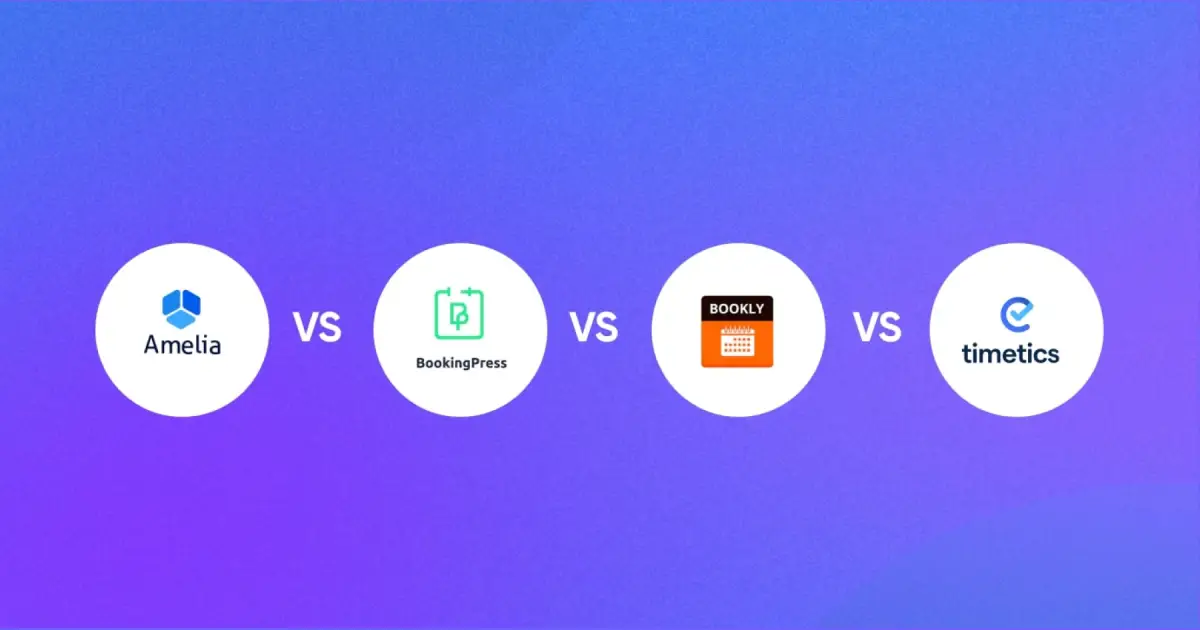How to Increase Blog Traffic: 20 Proven Strategies (2025 Edition)

You’ve been writing blog posts, but the traffic isn’t coming in like you hoped—maybe a few views here and there, but nothing steady. You’re not alone!
Getting people to read your blog content takes more than just hitting “publish.” It takes a system that connects the right content with the right readers at the right time.
In this blog, we’ll share how to increase blog traffic using 20 proven techniques. These techniques aren’t just theories; we’ve used them ourselves to boost blog traffic over time.
Let’s get started.
Why blog traffic matters (and what most people get wrong)
When most people think about blog traffic, they usually focus on numbers. More visitors, more pageviews, more sessions. And sure, those numbers can show growth, but it’s not the whole picture.
What really matters is why you want that organic traffic in the first place. Do you want people to read your posts, join your email list, buy something, or share your ideas?
Traffic only becomes valuable when it’s aligned with a real purpose. Otherwise, you’re just stacking up visits that don’t help your blog grow or lead anywhere.
Another common mistake is that people think traffic will appear if the content is good. But it doesn’t work like that anymore.
The internet is full of well-written blog posts that no one ever reads. In fact, 90.63% of content gets no traffic from Google. Not because it’s bad—just because no one sees it.
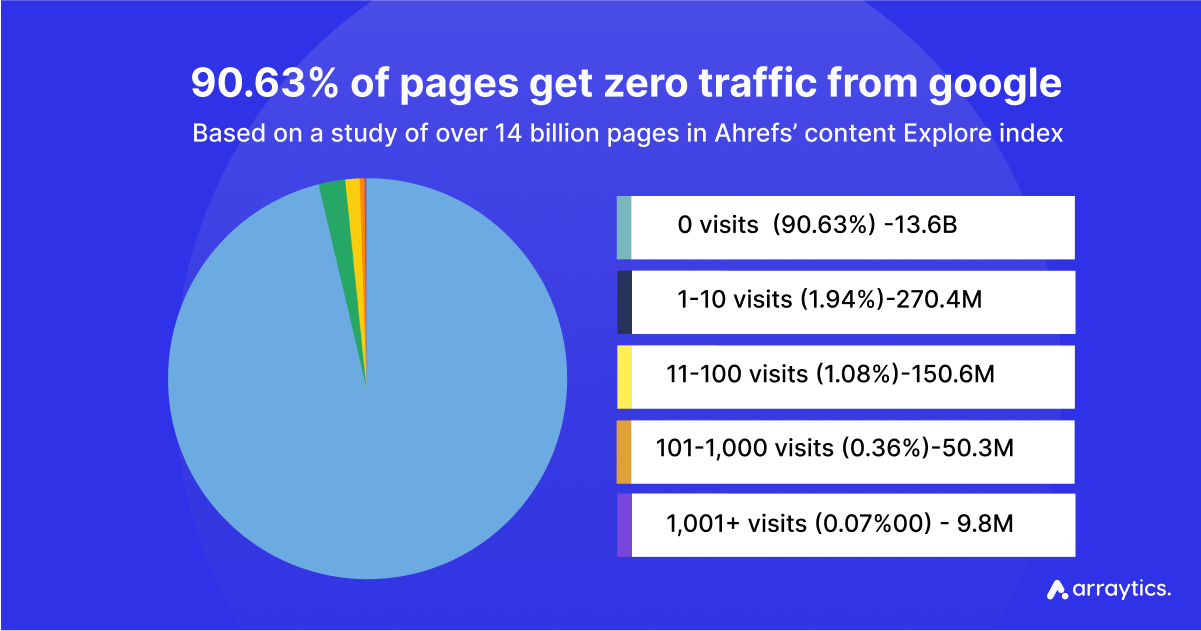
So, you must make your content easy to find, useful to read, and worth sharing. It’s not about going viral or writing every day. It’s about being smart with what you publish and how you promote it.
Yes, traffic matters. But not all traffic is equal. The goal isn’t just to drive traffic to your blog site. It’s to bring in readers who care, come back, and take action on what you share.
A few hundred engaged readers can be more valuable than a flood of one-time visitors who bounce in and out.
What most bloggers overlook about traffic growth
Most bloggers want more traffic, including us. That’s no secret. But in chasing numbers, many miss key things that make the difference. Here are some things that often get missed:
- Being so impatient about the result: The first thing many bloggers overlook is patience. Real traffic growth doesn’t happen overnight. It usually takes months of consistently publishing, learning, adjusting, and showing up even when nothing’s happening.
- Overnight expectation: It’s not about writing one great post now and then. It’s about showing up regularly with content that adds something worthwhile, even if it’s simple. A blog that publishes every week will almost always outperform one that posts occasionally, even if the writing isn’t perfect.
- Publishing without a traffic plan: Traffic doesn’t grow on its own. It’s not enough to publish regularly and hope people show up. Without a clear plan, such as using keywords and promoting content, traffic stays flat.
- Chasing empty pageviews: A spike in pageviews feels nice, but it doesn’t mean much if those visitors don’t stick around or take action. Fewer engaged readers are better than lots of random clicks.
- Getting traffic without direction: If your blog doesn’t guide people toward something, like subscribing, commenting, or exploring more content, even the best traffic won’t lead to lasting results. Guide them with links, signup boxes, or related posts.
- Ignoring content updates: Search results change. What worked a year ago might not rank today. Keeping content fresh is one of the easiest ways to bring traffic back.

20 proven ways to increase traffic in a blog
In the following section, you’ll find 20 best ways to get traffic to your blog—from writing better headlines and choosing the right keywords to using email and even leveraging AI. You can use these steps today, whether just starting or looking to grow what you’ve already built.
1. Understand your audience
Before you write anything, you need to know who you’re writing for. One of the easiest mistakes to make is writing for “everyone.” You usually reach no particular person when you try to speak to everyone.
But when your content feels like it was made for someone specific, someone who sees your post and thinks, “This is exactly what I needed.” It just means knowing a few simple things:
- What are they looking for?
- What questions do they have?
- What problems are they trying to solve?
If you skip this step, your content might miss the mark even if it’s well-written.
One way to learn about your audience is to look at what people are already searching for. Tools like Google Search Console, Answer the Public, Reddit, Quora, or even blog comments can show you what real people are asking. You can also check which posts get the most views or engagement.
When you understand who you’re talking to, everything from choosing topics to writing headlines becomes much easier. That’s how traffic starts to build by being helpful to the right people.
2. Target the right keywords (not just high volume)
It’s easy to think that big keywords with thousands of searches will bring in the most traffic. But that’s not always true.
High-volume keywords are often too broad and hard to rank for, especially if your blog is new or small. Instead, focus on keywords that match what your audience is really looking for, even if the numbers are lower.
These are called long-tail keywords. They’re more specific and often less competitive. For example, instead of “blog traffic,” try “how to get traffic to a new blog” or “blog traffic tips for beginners.”
Here are a few things to keep in mind while keyword research:
- Search intent matters, so make sure your content matches what they expect to find.
- A keyword with 200 monthly searches and low competition might bring in more traffic than one with 10,000 and no chance of ranking.
- You don’t need a fancy SEO tool like AHREF or Semrush to start. Free tools like Google Search Console, Ubersuggest, or even the Google search bar can give you valuable insights.
3. Write better headlines that get clicks
Your headline is the first thing people see on Google, social media, or your homepage. They’ll probably scroll past it if it doesn’t grab their attention or make them curious. That means even your best blog post might never get read.
Writing a good headline isn’t about being clever or dramatic. It’s about being clear. People want to know what they’ll get if they click. If your headline gives them that, they’ll likely check it out.
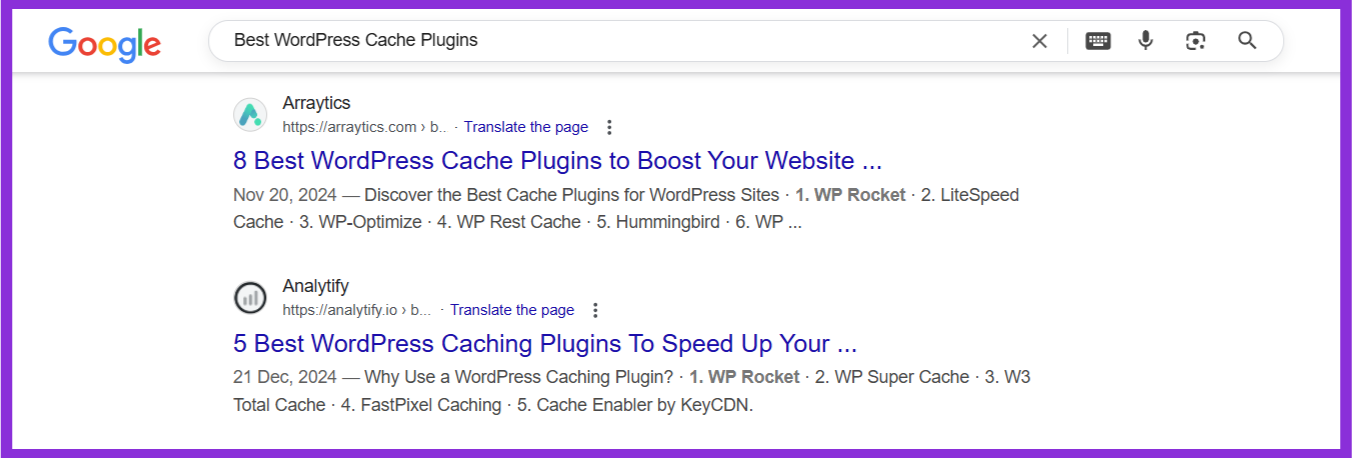
For example, instead of “Best WordPress Cache Plugins,” try “8 Best WordPress Cache Plugins to Boost Your Website Speed.” It’s more specific and sets a clear expectation.
Sometimes we try to be too creative and use phrases no one seeks. Do not make these mistakes; instead, use words your readers actually search for. Try typing your topic into Google and see what suggestions come up; those are often the words your audience uses.
You can also test headline ideas using tools like CoSchedule’s Headline Analyzer.
4. Create high-quality, helpful content
Once someone clicks your headline, the content has to deliver. You’ll often hear people say “just write quality content,” but that can mean different things depending on who you ask.
Quality content is simply content that helps someone do or understand something better than they could before. It doesn’t have to be perfect or packed with big words. It just needs to be useful.
Here are a few things to focus on:
- Always write for clarity, not complexity. You don’t have to sound like an expert. Just explain things in a way that makes sense. People will trust you if you can break something down without dumbing it down.
- Use headings, bullet points, and short paragraphs. It helps readers scan and find what they need, especially if they’re on mobile or in a hurry.
- You don’t need to write 2,000 words if the answer only takes 500. But if a topic requires more depth, don’t rush through it. Also, don’t just repeat what others are saying.
- Think like a reader. If someone finishes your post, what might they ask? If you have personal experience or a different angle, share it.
That’s what makes your content stand out. That’s what gets shared, and that’s what brings readers back.
5. Include visuals (infographics, videos, charts)
Sometimes words aren’t enough. A simple image, chart, or short video can explain something faster and better than a long paragraph. That’s where visuals come in.
Visuals help people understand what you’re saying. They break up long blocks of text, make your content easier to scan, and often keep readers on the page longer.
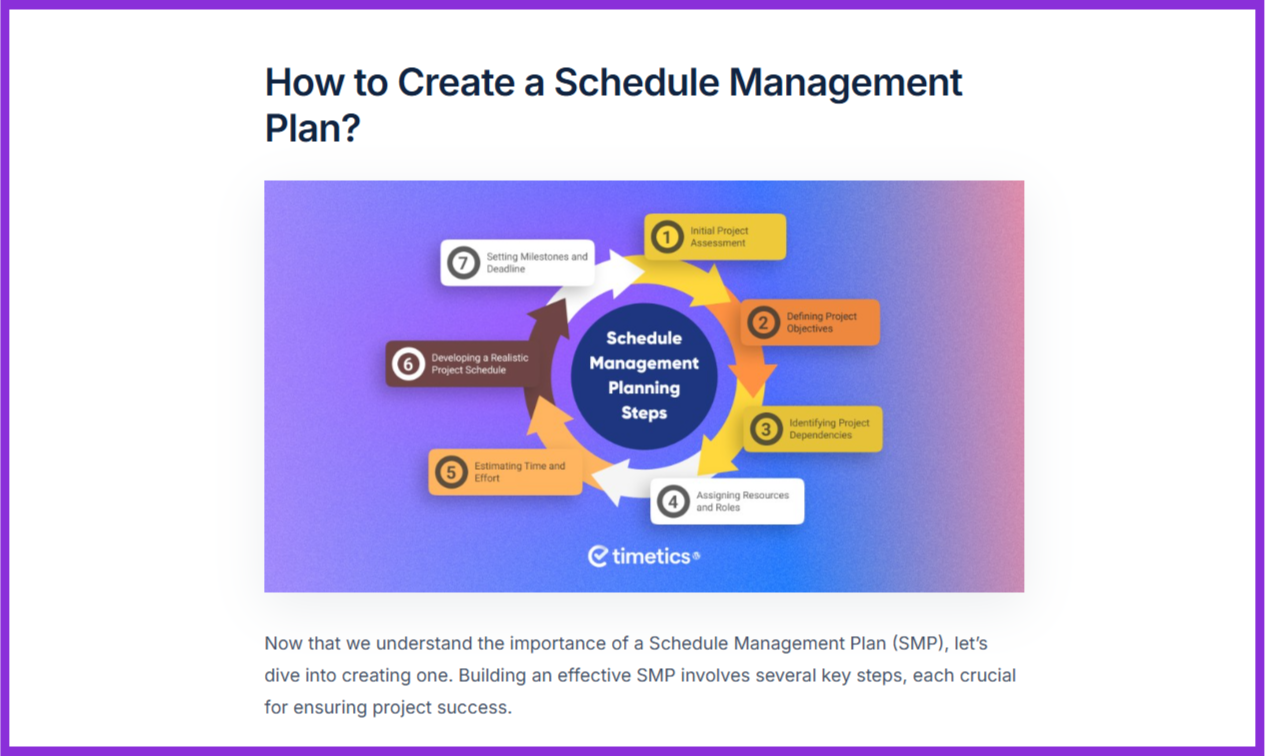
This matters, especially on mobile, where big chunks of text can feel heavy. Also, posts with images are more likely to get shared, especially if the visuals make the content easier to remember. A simple infographic that summarizes your main points can go a long way.
If you’re explaining a process, show a real example, like a step-by-step screenshot or a short screen recording. A chart or graph makes it easier to read if you display data. You don’t need to be a designer. Tools like Canva and Loom can help you create simple visuals quickly.
6. Create evergreen + trending content
A balanced content strategy includes both evergreen content and trending topics.
Evergreen posts are your long-term traffic builders. These are tutorials, guides, or answers to questions people will keep asking month after month. For example, “Common WordPress Errors and Quick Fixes for Newbies” or “Guide to Ensure WordPress Security, or How to Get Sponsorships for an Event.” They don’t go out of date quickly and often bring in steady search traffic.
Trending posts, on the other hand, can bring short bursts of attention. They’re tied to new tools, algorithm changes, yearly roundups, or current events in your niche. Something like “10 Best WordPress Booking Plugins in 2025” or “WP Timetics Vs. Amelia: Which One is The Best WordPress Booking Plugin?”
The smart move is to mix both. Use evergreen posts to build a strong foundation. Then sprinkle in trending topics to stay current and attract new readers. Tools like Google Trends, X, and Exploding Topics can help you spot what’s rising in your niche. Just ensure that even with trends, your content stays useful, not just rushed.
7. Demonstrate Google E-E-A-T signals
E-E-A-T stands for Experience, Expertise, Authoritativeness, and Trust. It’s Google’s way of deciding if your content is worth showing to people. It’s not a direct ranking factor like keywords or backlinks, but it still affects how Google and your readers see your content.

The idea is simple: the more you can show that you know what you’re talking about and that readers can trust you, the more likely your content will do well over time. So, how do you ensure E-E-A-T on your blog? Here’s how:
- Start with experience. If you’ve done something you’re writing about, say it. Real examples, personal stories, or lessons you’ve learned go a long way. Google explicitly values content that reflects first-hand experience, especially for product reviews and how-to content.
- Next is expertise. This doesn’t mean you need a fancy degree. It just means you know what you’re talking about. Explain things clearly, back up your points with facts, and link to reliable sources when it makes sense.
- Authoritativeness comes from how others see you. If trusted sites link to your content, that’s a strong signal. Guest posts, interviews, or even mentions on social media platforms can help build this over time.
- Trust is built through small details. Use your real name. Add an author bio. Make sure your site looks clean and works well. Be transparent about what people get if you ask for emails or money.
8. Optimize for on-page SEO (Search engine optimization)
On-page SEO is about making each blog post easy for search engines and people to understand. It’s not complicated; you don’t have to be an SEO expert. Most of it comes down to doing a few simple things every time you hit publish.
Here are the basics:
- Use a clear, descriptive title. Your title should include the primary keyword or phrase your post is about. It doesn’t have to be forced; just ensure it clearly reflects the topic.
- Write a good meta description. This is the summary that shows up in search results. It doesn’t affect rankings directly, but it can make more people click. Write a summary (under 160 characters) that tells people what they’ll get from your post.
- Use headers to organize your content. Break up your post with H2s and H3s where it makes sense. This will help readers skim and help search engines figure out the structure of your post.
- Include your keyword naturally. Try to include your target keyword in the first paragraph, in one or two subheadings, and once or twice in the body. But don’t overdo it; it should feel natural.
- Add internal and external links. Link to other helpful posts on your blog and trusted sources outside your site. This will give your content more context and help readers explore further.
- Use alt text for images. This helps with accessibility and gives search engines more information about the page.
- Make sure your URL is clean. A simple URL like /optimize-on-page-seo is better than one with random numbers or unnecessary words.
9. Add internal links to high-traffic pages
Internal linking is one of those things that’s easy to overlook but makes a real difference over time. It’s a way to guide readers from one post to another, helping them find more of what interests them and keeping them on your site a little longer.
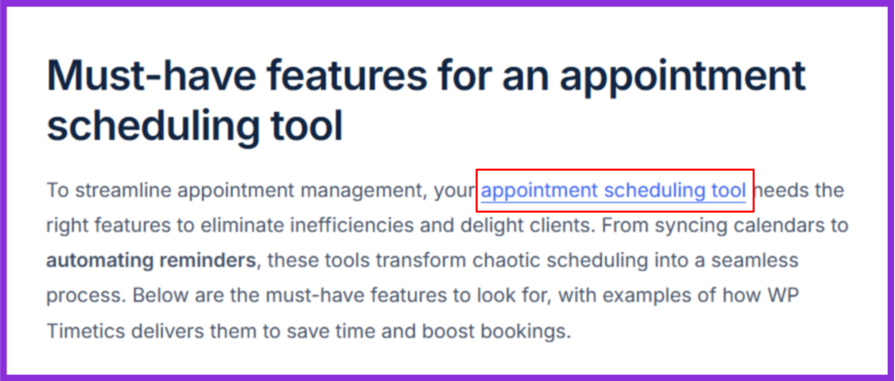
But here’s where it gets more strategic: not all links are equal. Some pages on your site naturally get more traffic than others. When you link from those high-traffic pages to posts that need a little boost, you’re spreading that visibility around in a helpful way.
Here’s how to think about it:
- Use tools like Google Analytics or Jetpack to see which posts get the most visits. These are the ones that already have momentum.
- If you have a high-traffic post about SEO basics and a newer post about writing meta descriptions, that’s a natural connection. Add a short sentence or link in the body to guide readers there.
- Use clear anchor text—the clickable words in your link. Instead of writing “click here,” use something like “check out our guide to blog headlines.” It’s better for both the reader and SEO.
- Whenever you publish a new post, think about where it could link from and where it could link to. Over time, this builds a stronger structure for your blog.
10. Promote every blog post on social media (not just once)
Publishing a blog post is just the start. If you want people to read it, you have to share it, and social media is one of the simplest ways to promote blog posts.
The mistake most people make is sharing a post once and then moving on. But most of your audience won’t see that first share. Timelines move fast, algorithms change, and people scroll past a lot. If you don’t reshare it, you leave traffic on the table.
You don’t need to be everywhere. Just pick the platforms where your audience spends time, like Twitter, LinkedIn, or Facebook, and post there regularly. You can also schedule posts using tools like Buffer or Publer.

That way, your content will continue to be shared even when you’re busy, and eventually, your blog views will increase without spending money.
11. Leverage topic clusters
One blog post can be helpful. A group of related posts that link to each other? Even better. That’s what topic clusters are about: creating a group of connected content around a single theme, making it easier for readers (and search engines) to understand your site.
At the center of a topic cluster is a broad post, sometimes called a “pillar” page. It covers the main topic in a general way. Then, you write supporting posts that dive deeper into specific parts of that topic. Each post links to the others and connects back to the main one.
Here’s how it works: You write a detailed post about a broad topic like “How to Create a Schedule Management Plan for Project Management.” Then, you write posts about related topics like “Top Booking Plugins for Efficient Appointment Scheduling,” “How to Schedule a Meeting With WP Timetics,” and more. You link all of these to the main post, and the main post links back to them.
This structure makes your blog easier to navigate. It also shows search engines that you’ve covered a topic in depth, which can improve your chances of ranking. You don’t need to plan a complete cluster all at once. You can build it over time. Just keep linking related content as you go.
12. Use email marketing to drive traffic
Social media posts come and go. Search rankings can change. But email? That’s a direct line to your readers; you don’t need to fight an algorithm to reach them.
Email is one of the most reliable ways to bring people back to your blog. If someone has joined your list, they already care about what you’re sharing. Now it’s your job to stay in touch.
You don’t need a fancy setup for your email marketing strategy. Just send a quick email when you publish something new. A simple message with a clear link to your latest post is enough. You can also share a weekly or monthly roundup to keep subscribers in the loop.
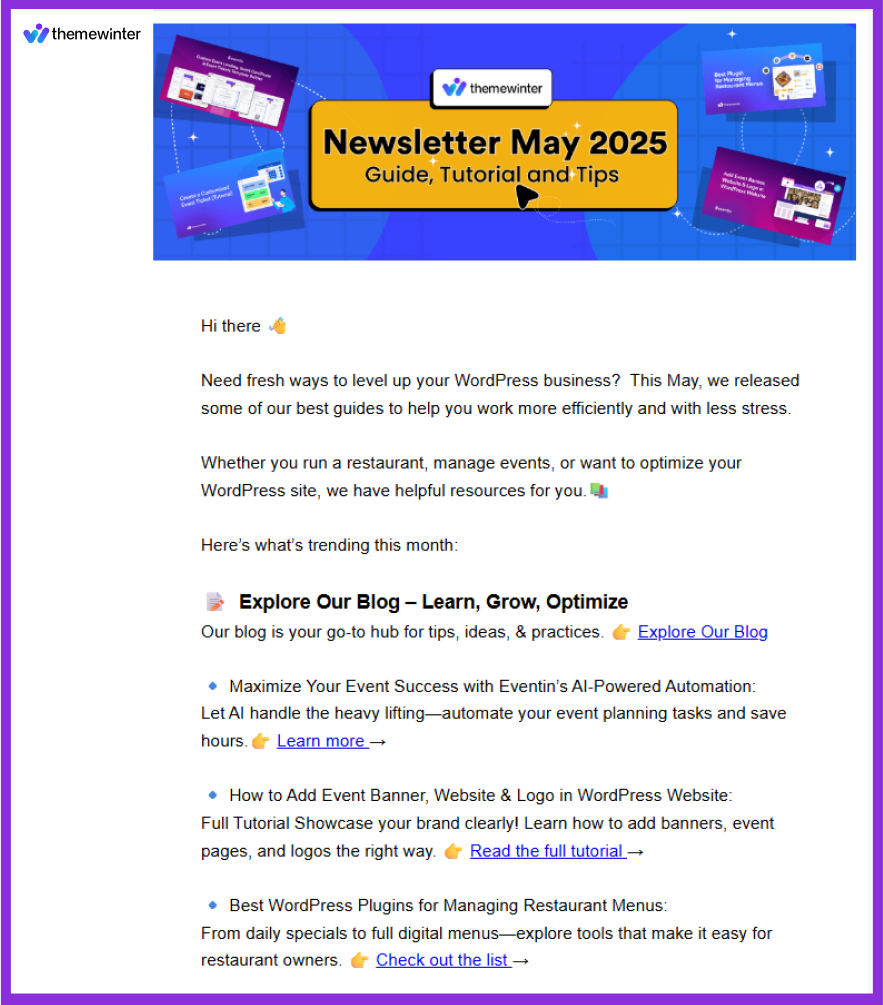
The goal is to make it easy for subscribers to stay connected with your content and to give them a reason to click. Instead of a generic “New blog post,” try highlighting a benefit: “Let AI handle the heavy lifting—automate your event planning tasks and save hours.👉 Learn more”
13. Build your email list with lead magnets and popups
Your email list is one of the few things you own online. The more you grow it with people who want to hear from you, the easier it becomes to bring traffic back to your blog regularly.
But growing a list doesn’t happen by accident. It takes a mix of the right timing, a clear message, and tools that make it easy for readers to sign up.
Here’s how to approach it:
- To grow your list, offer something valuable in exchange for an email. This is called a lead magnet. It could be a short guide, a checklist, or a free template. Keep it simple and ensure it’s connected to the topic they’re reading.
- Popups help you show the offer at the right time. You can trigger them when someone scrolls down, stays on the page for a while, or moves to close the tab. Popup tools like Poptics and OptinMonster make this easy to set up.
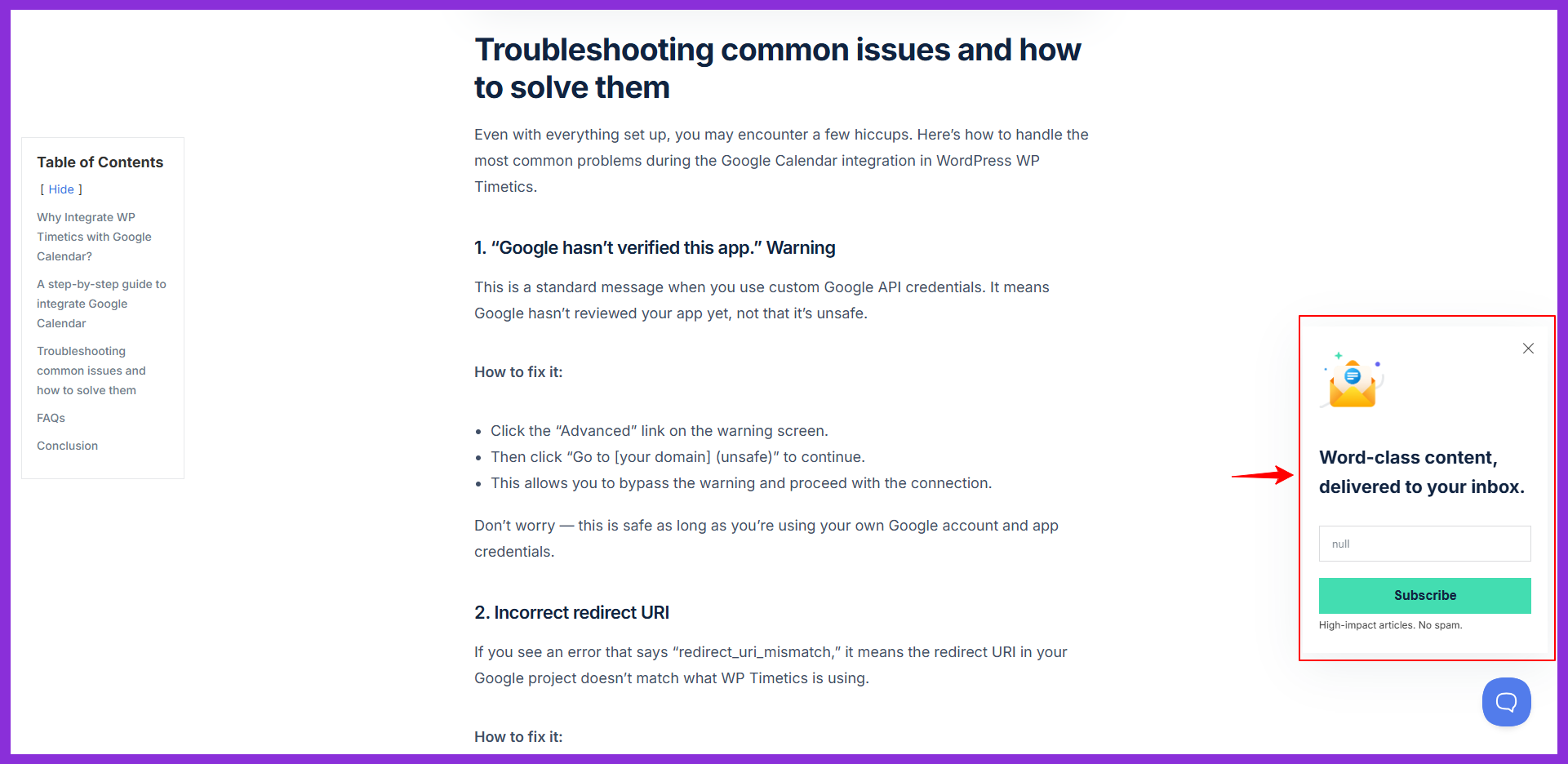
- Add signup forms in other spots, like the end of a post or in the sidebar. Once someone joins, send them something useful now and then. It could be a new blog post, a tip, or a short update.
- Focus on quality, not just quantity. A smaller list of readers who regularly open, click, and visit your blog is more valuable than an extensive list that never engages.
14. Write guest posts and appear on other blogs
One of the simplest ways to bring new readers to your blog is to show up somewhere they already are. That’s what guest posting is all about: writing for someone else’s blog, sharing your perspective, and giving people a reason to check out your own site.
You don’t need to pitch big websites right away. Start with smaller blogs in your niche. Look for ones that accept guest posts and have an active audience. Reach out with a clear idea for a helpful post, and tell them why it might be a good fit.
It’s not about promoting yourself. It’s about being helpful in someone else’s space and earning trust. When done well, guest posts can lead to steady traffic, new subscribers, and even new relationships with other creators in your niche.
15. Repurpose your existing content
You don’t have to start from scratch every time you want to share something new. Repurposing lets you take what you’ve already written and turn it into different formats for other places.
For example, you can turn a blog post into a Twitter thread, a LinkedIn post, or a short video. If your post has steps, stats, or comparisons, you can turn that into a quick graphic.
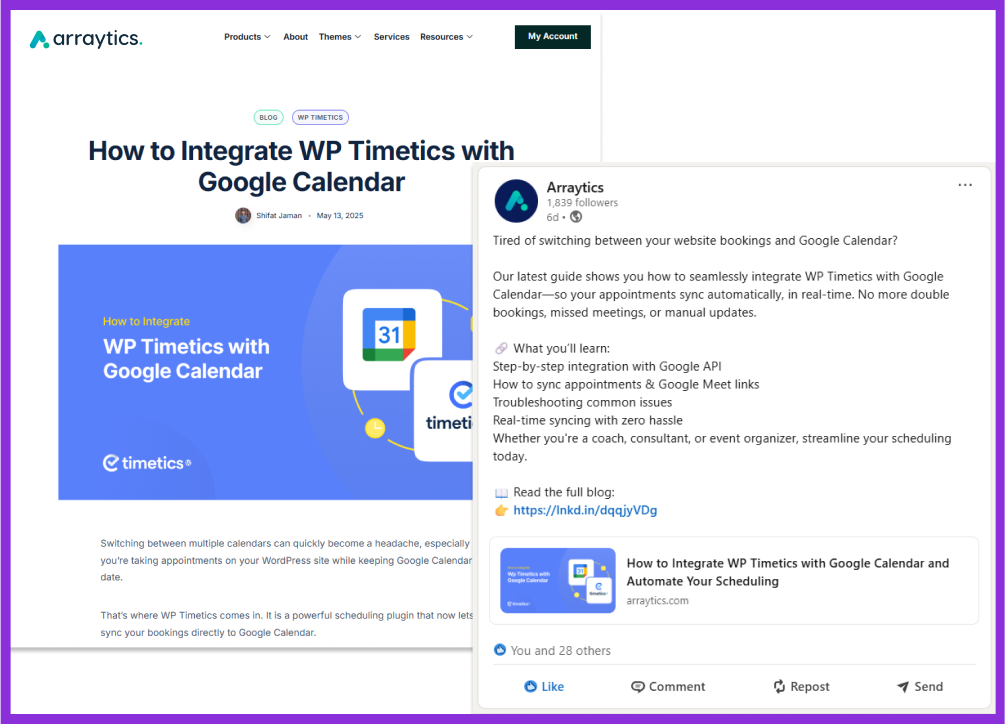
If you’ve written several pieces on the same topic, bundle them into a PDF or a new pillar page. You can even send the post to your email list, including the link.
This helps you reach people who might not read blogs but still follow you on other platforms. It also gives your content life, instead of getting buried after a few days.
16. Engage in online communities
Some of your best readers are already hanging out in places like Reddit, Facebook groups, forums, or Slack channels. These are communities built around shared interests, and if your blog fits the topic, it’s a good place to join the conversation.
However, the key is to join as a participant first, not as someone trying to promote something. Spend time reading what people are asking. Join discussions. Share your blog posts only when they help answer a question or add something useful.

You can also share tips, give feedback, or ask your own questions. But stay consistent. The more people see you as someone who adds value, the more likely they will check out your content. Remember, this kind of traffic builds slowly.
17. Use WordPress SEO tools for analytical purposes
WordPress makes it easy to manage your blog, but SEO plugins can give you an extra edge when it comes to search engine visibility. SEO plugins like Rank Math or AIOSEO go beyond just optimizing your posts; they also help you understand how your content performs over time.
When connected to Google Search Console, these plugins (keyword research tools) can show which keywords your blog content is ranking for, which pages are getting the most clicks, and where there may be room for improvement.

While the data is limited compared to complete analytics tools, it’s a helpful snapshot that helps you understand what’s working. Checking your SEO performance regularly can help you improve blog traffic and learn how to improve your blog traffic with small updates.
18. Refresh and republish old posts
Not every blog post needs to be new. Sometimes the best way to get more traffic is to update your written content. Even Google encourages updating old content as long as the changes are meaningful.
Over time, older posts can lose their spot in search results. The information may be outdated, or newer posts have replaced it. Either way, refreshing the content can bring it back to life.
Here’s how to approach it:
- Start by looking at posts that used to get traffic but no longer do. Use tools like Google Search Console or your WordPress analytics plugin.
- If you mention tools, stats, or techniques, ensure they’re still accurate. Replace anything that’s no longer relevant or available.
- Fix broken links, improve the headline, or add new examples. You might spot a better keyword to target, or the meta title and description could be clearer.
- Improve formatting and readability. If the post was short, expand it. If it was cluttered, simplify it.
Once you’ve made your changes, update the publish date and resubmit the post in Google Search Console. This tells Google to recrawl the page.
19. Use AI to scale content
AI is changing the way people create content. AI tools like ChatGPT, Claude, or Jasper can help you get more done without starting from scratch every time. You can use it to plan outlines, come up with headlines, or turn blog posts into quick summaries for social media or newsletters.
A lot of bloggers also use AI to build content briefs. You type in a keyword or topic, and it gives you a rough structure. From there, you can shape the post in your own words and add your own examples.
A Semrush study analyzed 80 million ChatGPT prompts and found that around 70% of queries use a flexible, “unknown” intent—people asking to brainstorm, explain, or explore ideas. This highlights how AI reflects real user search behavior and can expose new topic angles or content gaps.
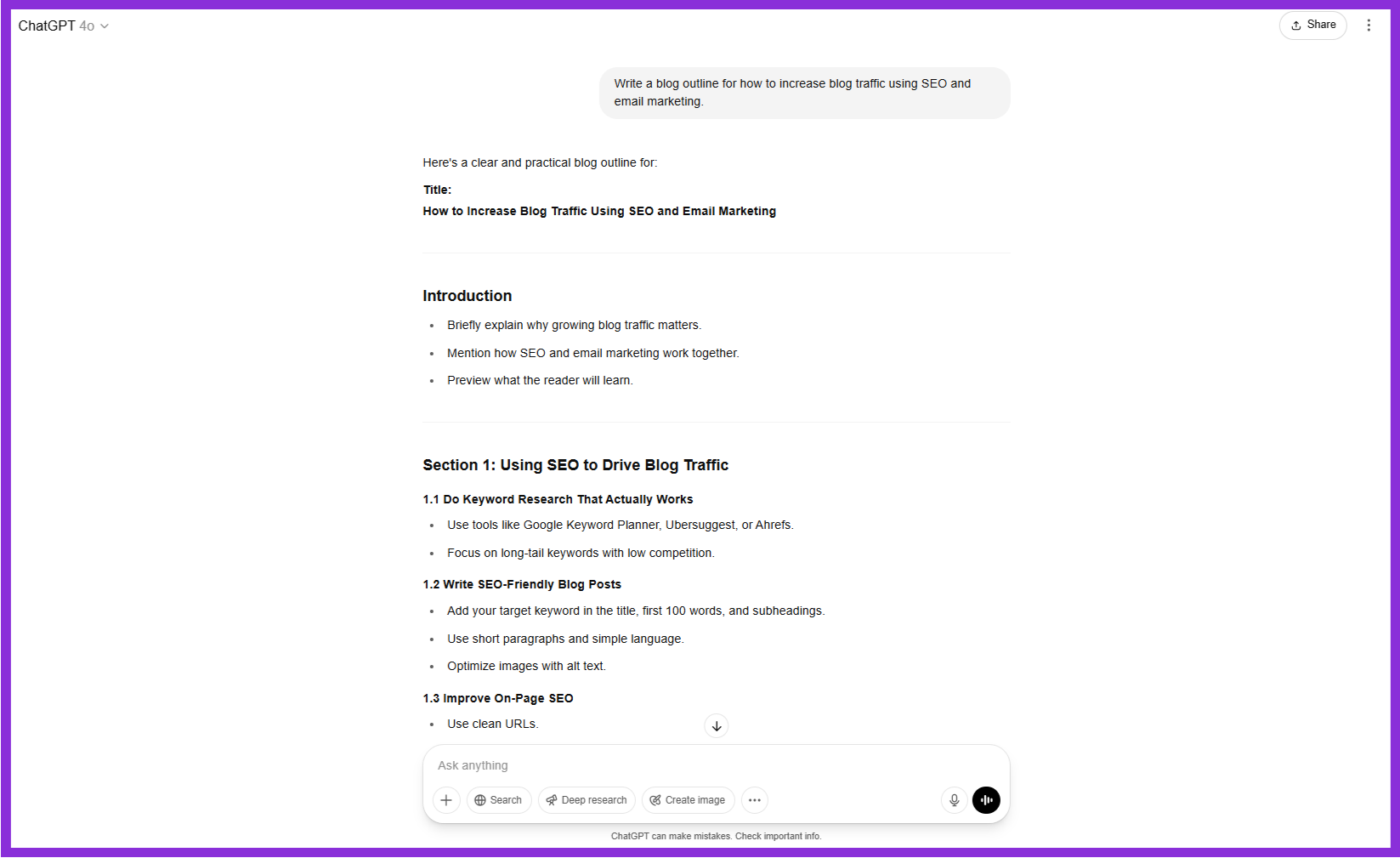
Something else to keep in mind—ChatGPT now sends traffic to over 30,000 websites every day. Most of those searches aren’t just keywords like “best blog tools.” They’re more open-ended, like “what’s a good way to grow a blog if you’re just starting?” or “how should I promote a post after publishing?”
That kind of search shows how people are looking for answers, not just keywords. You can use ChatGPT to explore those kinds of questions and shape content that speaks to them. It’s a good way to find topics that might not show up in regular SEO tools, but still matter to real readers.
20. Improve page speed and mobile UX
If your blog takes too long to load or doesn’t work well on a phone, people are likely to leave before they even see your content, and search engines pick up on that. Even just a few extra seconds can be enough to turn someone away, no matter how good your post is.
Tools like Google PageSpeed Insights or GTmetrix can show you what might slow things down. Common fixes include compressing images, reducing unnecessary plugins, or using a caching plugin to help pages load faster.
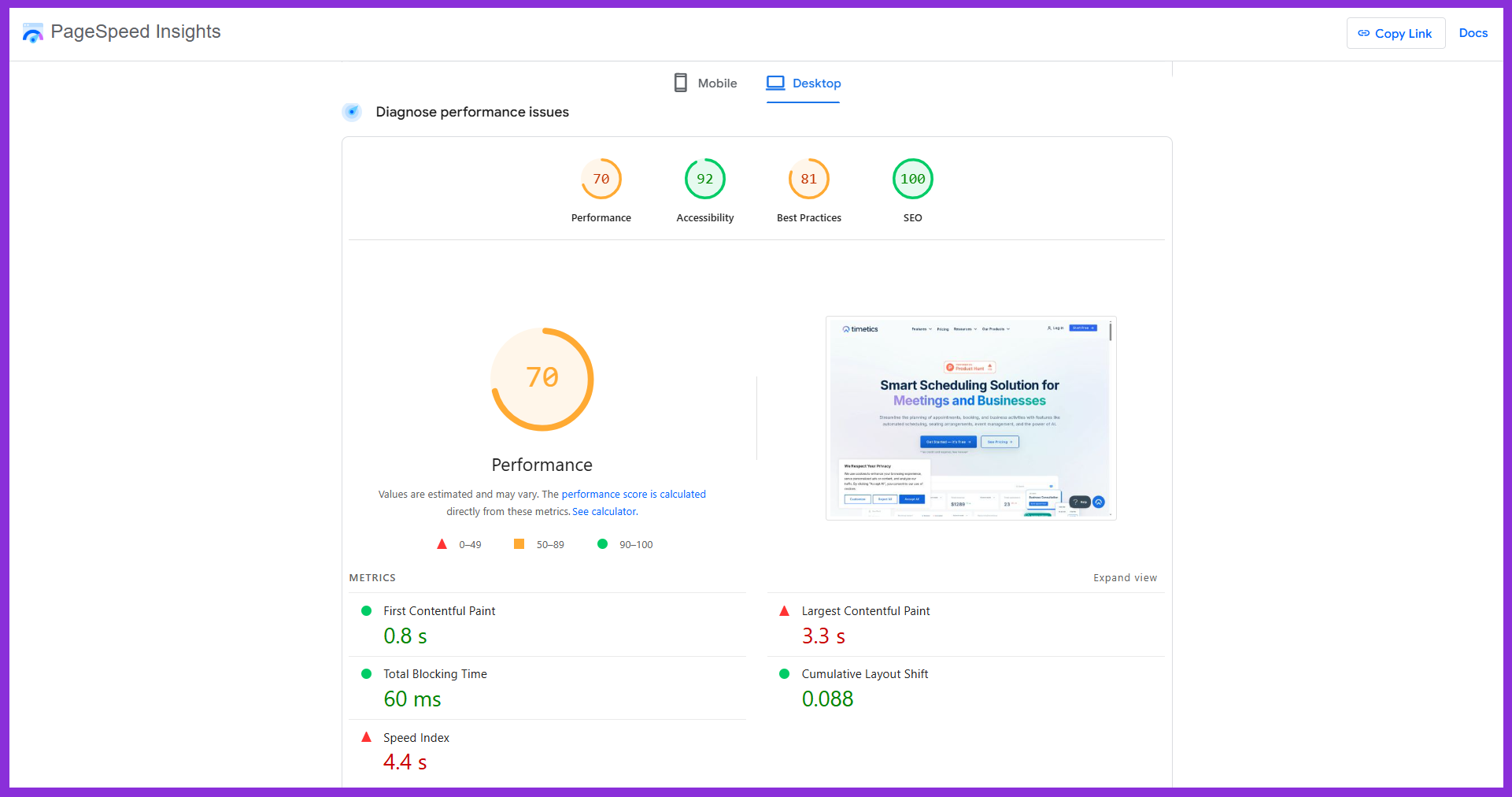
It’s also worth checking how your site works on a phone. Many people browse on their phones now, so if your blog is hard to read or tap through on a small screen, they might not stick around. Go with a clean layout, readable text, and easy-to-press buttons.
When ranking content, Google looks at speed and usability, especially for mobile searches. Improving these two things helps your readers and your rankings.
Bonus: Never do these seven things if you really want to grow your blog traffic
Even with the right strategies, a few missteps can slow your progress in driving traffic to blog. Here are some common traffic mistakes many bloggers make and how to avoid them.
- Writing without a plan: Jumping from topic to topic without a clear structure or niche makes it harder to build a loyal audience or rank well in search. Planning, like topic clusters, helps keep your content focused and connected.
- Focusing only on pageviews: Traffic numbers can be misleading if they aren’t connected to any real goal. More important than total visitors is what those visitors do, whether it’s subscribing, reading more posts, or taking some action.
- Ignoring search intent: Ranking for a keyword doesn’t help much if the content doesn’t match what people expected to find. Ensure each post answers the question or solves the problem behind the search.
- Publishing without promotion: Writing a blog post is only part of the process. If you’re not actively sharing, repurposing, or linking to it, it may not get the traffic it deserves. Promotion needs to be built into your workflow.
- Not updating old content: Letting older posts go untouched for years can hurt your blog’s credibility and rankings. A quick refresh, updating links, images, or examples, can give older content a second life.
- Skipping the basics of SEO: You don’t need to master every SEO technique, but skipping simple things like optimized headings, meta descriptions, or internal links can make it harder for your content to be found.
- Trying to do everything at once: From SEO and social media to email, video, and AI tools, it’s easy to feel like you have to be everywhere. But spreading yourself too thin often leads to burnout. It’s more effective to start small, stay consistent, and add new strategies slowly.
Conclusion
Getting more blog traffic isn’t about doing one big thing. It’s about doing many small things consistently rather than chasing trends. You don’t need to try everything at once; start with a few manageable strategies that fit how you like to work.
If you are still wondering how to improve your blog traffic, these beginner tips to get blog traffic give you a clear place to start. You don’t have to guess. Just stay consistent. See what works, adjust as you go, and give it time. The traffic will come, and so will the readers who stick around.
FAQs on how to increase blog traffic
How long does it take to get traffic to a new blog?
It depends on your niche, how often you publish, and how consistent your promotion is. It takes at least 3–6 months for most new blogs to start seeing steady search traffic, sometimes longer.
What is the best free way to increase blog traffic?
The most reliable free method is search engine traffic, which comes from writing content that matches what people seek. After that, sharing in relevant online communities and building an email marketing strategy is a strong option that costs nothing but time.
Do popups help grow blog traffic?
Popups help you collect emails, and your email list brings people back to your blog. So while popups don’t boost search traffic, they help you keep the traffic you already earned.
Should I run ads to boost blog traffic?
You can, but it’s not usually the best move for new blogs unless you have a clear goal. Ads can bring quick visits, but don’t guarantee engagement or lasting growth.
How often should I publish new blog posts?
There’s no perfect number. What matters more is consistency. If you can post once a week, that would be great. If it’s once a month, that’s fine, too. Just stick with it and keep improving your content over time.
Why is my blog not getting any traffic?
There could be several reasons: the content might not match what people are searching for, your site might be hard to navigate, or you’re simply not promoting it enough. Look at your analytics to see where people drop off, and start adjusting.



